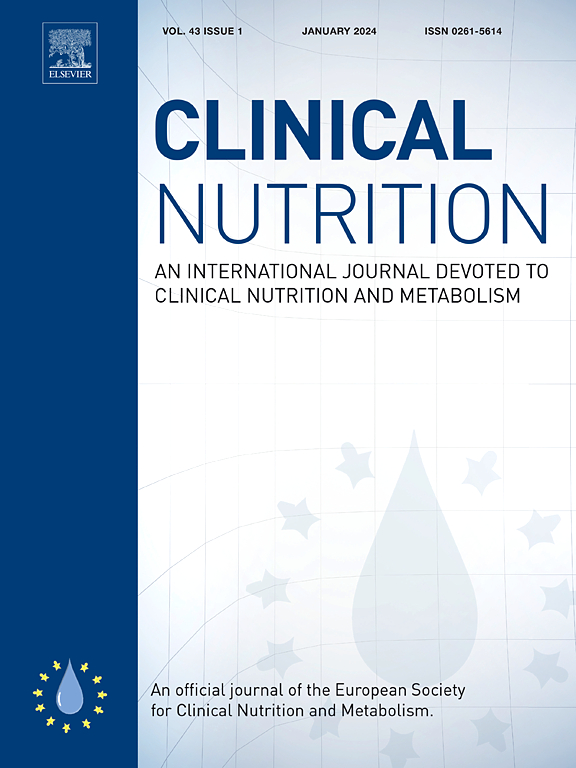Associations between sarcopenic, obesity, and sarcopenic obesity and metabolic syndrome in adults aged 45 Years or older: A prospective cohort study from the China health and retirement longitudinal study
IF 6.6
2区 医学
Q1 NUTRITION & DIETETICS
引用次数: 0
Abstract
Background
Although previous studies have reported associations between sarcopenic obesity (SO) and metabolic syndrome (MetS), the findings remain inconsistent. This study aimed to investigate the associations between sarcopenia, obesity, and MetS, and to determine whether sarcopenic obesity synergistically increases the risk of MetS.
Methods
The data were extracted from the China Health and Retirement Longitudinal Study (CHARLS) in 2011 and 2015. Participants were categorized into five groups: non-sarcopenia non-obesity, non-sarcopenia obesity, non-obesity sarcopenia, possible SO, and SO. MetS was defined using the diagnostic criteria recommended by the National Cholesterol Education Program Adult Treatment Panel III. Logistic regression models were employed for both cross-sectional and longitudinal analysis.
Results
In 2011, a total of 9322 participants were included in the cross-sectional analysis, with 3674 individuals followed up in 2015. In the cross-sectional study, non-sarcopenia obesity (OR = 9.20, CI: 8.06 to 10.50), possible SO (OR = 2.04, CI: 1.94 to 2.15), and SO (OR = 1.61, CI: 1.47 to 1.77) were associated with a higher prevalence of MetS. In contrast, non-obesity sarcopenia (OR = 0.85, CI: 0.74 to 0.98) was associated with a lower prevalence. In the longitudinal analysis, non-sarcopenia obesity (OR = 2.87, CI: 2.34 to 3.52) and possible SO (OR = 1.41, CI: 1.30 to 1.53) were associated with an increased incidence of MetS, while non-obesity sarcopenia (OR = 0.75, CI: 0.62 to 0.91) was associated with a reduced incidence. Notably, SO (OR = 1.00, CI: 0.80 to 1.25) was not associated with the incidence of MetS.
Conclusion
Possible SO, defined by low muscle mass, was not associated with subsequent new-onset MetS. This study highlights that the obesity component, rather than the muscle mass component, is the primary driver of MetS risk in middle-aged and older adults in China.
45岁及以上成年人肌肉减少、肥胖、肌肉减少性肥胖和代谢综合征之间的关系:来自中国健康和退休纵向研究的前瞻性队列研究
虽然以前的研究报道了肌肉减少性肥胖(SO)和代谢综合征(MetS)之间的联系,但研究结果仍然不一致。本研究旨在探讨肌肉减少症、肥胖和MetS之间的关系,并确定肌肉减少性肥胖是否会协同增加MetS的风险。方法数据来源于2011年和2015年的中国健康与退休纵向研究(CHARLS)。参与者被分为五组:非肌肉减少症非肥胖,非肌肉减少症肥胖,非肥胖肌肉减少症,可能的SO和SO。MetS是根据国家胆固醇教育计划成人治疗小组III推荐的诊断标准来定义的。采用Logistic回归模型进行横断面和纵向分析。结果2011年共纳入9322人,2015年随访3674人。在横断面研究中,非肌少症肥胖(OR = 9.20, CI: 8.06至10.50)、可能的SO (OR = 2.04, CI: 1.94至2.15)和SO (OR = 1.61, CI: 1.47至1.77)与较高的MetS患病率相关。相反,非肥胖型肌肉减少症(OR = 0.85, CI: 0.74 - 0.98)的患病率较低。在纵向分析中,非肌少症肥胖(OR = 2.87, CI: 2.34至3.52)和可能的SO (OR = 1.41, CI: 1.30至1.53)与met发生率增加相关,而非肥胖性肌少症(OR = 0.75, CI: 0.62至0.91)与发生率降低相关。值得注意的是,SO (OR = 1.00, CI: 0.80 ~ 1.25)与MetS的发生率无关。结论由低肌肉量定义的可能的SO与随后新发的MetS无关。这项研究强调,肥胖成分,而不是肌肉质量成分,是中国中老年人群met风险的主要驱动因素。
本文章由计算机程序翻译,如有差异,请以英文原文为准。
求助全文
约1分钟内获得全文
求助全文
来源期刊

Clinical nutrition
医学-营养学
CiteScore
14.10
自引率
6.30%
发文量
356
审稿时长
28 days
期刊介绍:
Clinical Nutrition, the official journal of ESPEN, The European Society for Clinical Nutrition and Metabolism, is an international journal providing essential scientific information on nutritional and metabolic care and the relationship between nutrition and disease both in the setting of basic science and clinical practice. Published bi-monthly, each issue combines original articles and reviews providing an invaluable reference for any specialist concerned with these fields.
 求助内容:
求助内容: 应助结果提醒方式:
应助结果提醒方式:


